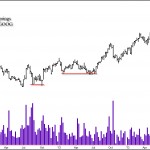Wyckoff is certainly alive and well in the modern markets. There is probably no more modern stock than Google (GOOG). It is on the cutting edge of technology and the internet. Despite how ‘modern’ GOOG is, it behaves according to Wyckoff principles. This is true for all liquid markets. Take a look at the weekly chart.
 We have springs occurring in early October 2011, another late June 2012, and one just this past week. That’s one each year in this stock alone for very nice moves. Other ‘modern’ stocks show similar Wyckoff principles, including spring setups.
We have springs occurring in early October 2011, another late June 2012, and one just this past week. That’s one each year in this stock alone for very nice moves. Other ‘modern’ stocks show similar Wyckoff principles, including spring setups.
Springs are great trade setups because they have strong odds of success and they define what Wyckoff called the ‘danger point,’ i.e., the price at which you know you are wrong. Too many traders want to always be right. That’s just not possible. Even a spring setup will fail on occasion. What I teach in Deep Practice and the various tutorials we’ve put out is this: See your stop (the danger point) before taking a trade. Know where the danger point is located and trade against that. Springs make this easy because they have a clear danger point close to entry. In many cases, spring trades do not entail large risk. High odds of success, a clear danger point and low risk stops make springs the bread & butter setup that Wyckoff traders trade day in and day out.
This last spring took GOOG up above $1,000 a share. Very nice.
For more information on springs and how to trade them, see: Wyckoff Spring Tutorial
For more information on my weekly Deep Practice program, see: Deep Practice

Leave a Reply